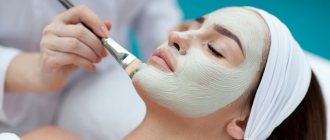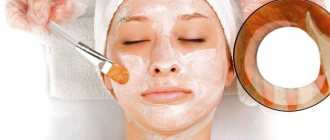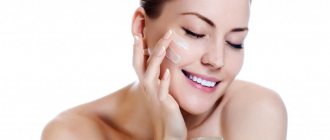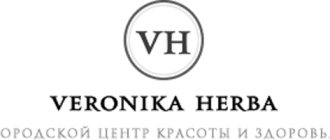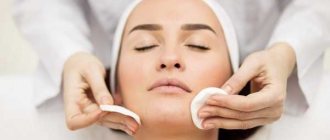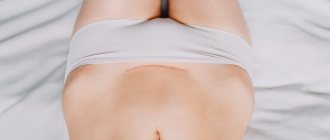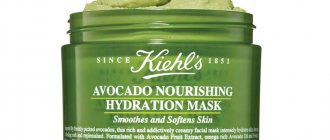Cosmetologists prescribe Bepanten after peeling only in cases of medium or deep exfoliation. Radical cleansing and rejuvenation techniques can cause significant damage to the upper layer of the epidermis. Therefore, in some cases, it is possible to accelerate skin regeneration only with the help of medications based on panthenol. Many women do not know what to prefer: ointment or cream, and what is the difference between them. We will tell you further about why you need to use wound healing products from the pharmacy after peelings, how long the care should be and whether there are any restrictions.
Main principles of skin care after chemical peeling
Regardless of the type of peeling used and the degree of its penetration into the layers of the skin, there are a number of requirements that must be strictly observed during the recovery period.
Under no circumstances should you touch your face on the first day . This means that any procedures related to washing, applying moisturizers, etc. are prohibited. The only exceptions are special instructions from a cosmetologist regarding the specifics of the procedure itself. For example, with retinoic or yellow peeling, you will need to remove the product from your face yourself in strict accordance with the recommendations received. It is undesirable to touch your face in the following days, since injured skin is very susceptible to the action of bacteria that can cause serious inflammatory processes.
You can only wash your face the next day with clean boiled water . The cleansers used should be mild and should be applied to the face carefully, using your fingertips. During the recovery period - and after chemical peeling, it can take up to 2 months - you should avoid using scrubs, which will further injure the epidermis and can lead to scarring.
To alleviate the condition, as well as to prevent the skin from cracking and cracking whenever severe tightness appears, it is recommended to use moisturizing gels or foams that are easy to apply and absorb well. It is better not to use creams at first - their time will come when the skin begins to peel off. In this case, it is advisable to select products with moisturizing, antioxidant, anti-inflammatory, regenerating properties - the composition will include selenium, omega acids, Shea butter, hyaluronic acid, retinol, etc.
An excellent product for moisturizing the skin and accelerating the regeneration process is Panthenol spray - it is advisable to purchase it in advance and always have it on hand. Panthenol is generously applied to the facial skin several times a day (3-4 after superficial peeling and 7-8 after medium peeling) until the skin is completely restored. Excess Panthenol should be easily removed with a clean cloth after a quarter of an hour. Despite all the advantages of Panthenol, it must be used in accordance with the recommendations: after superficial chemical peeling - a day later, after medium peeling - no earlier than 3-4 days (by this time a strongly constricting film will appear on the face, with a color ranging from normal to brown).
No one denies the positive effects of various soothing masks made from natural ingredients on irritated skin, but it is better not to resort to them on your own during the post-peeling period. Here you need a preliminary consultation with a cosmetologist, since even the most familiar product can become a strong allergen and cause irritation.
Why does skin require care?
No matter how gentle and careful exfoliation is, for the skin it is damage and stress, and in the case of radical lifting techniques - an acid or thermal burn of I-II severity. Effective medium and deep peels, chemical as well as physical, destroy the integrity of the skin and adjust the internal processes in the epidermis in a new way. Blood flow is stimulated, collagen and elastin fibers are formed at an accelerated rate, the skin is saturated with nutrition and oxygen. But on the way to noticeable rejuvenation and effective removal of defects in appearance, women have to deal with itchy redness, inflammation and extensive skin exfoliation.
Even an experienced cosmetologist cannot accurately predict what reaction chemical peeling with acids, diamond or laser resurfacing of the face will cause. It must be remembered that the body’s immune response to an external stimulus may be typical, or it may be unpredictable and the consequences of such a procedure will become extremely undesirable. Therefore, it is so important to regularly and properly take care of the skin in the post-peeling period, selecting proven drugs and methods. Careless treatment of defenseless skin can not only minimize the results of peeling, but also make the face repulsive.
Skin reactions after peeling go through three main stages. The woman begins to notice the first changes in appearance from the next day after the procedure and over the next 2 weeks. From 2 to 6 weeks after exfoliation, a period of active regeneration begins, during which the skin changes again. The final stage (1-2 months after peeling) are complications caused by the unprofessionalism of the cosmetologist or violation of the procedure protocol.
Typical skin reactions, no matter how unpleasant they may be, cannot be regarded as side effects or complications. They can easily be minimized using classic post-peeling skin care products. The following skin conditions are expected after the procedure:
- dehydration of the epidermal layer from its upper layers to the basement membrane of the epithelium (depending on the depth of penetration of the active substance);
- redness of the skin against the background of a sharp expansion of capillaries. Can be stored for a week;
- dryness and peeling of the keratinized epidermis;
- swelling and sagging skin, especially in the eye area and décolleté area;
- change in skin tone from light brown to brown after deep chemical peels and laser resurfacing.
An individual plan for skin restoration after peeling is drawn up for the patient by a cosmetologist at the very beginning of the exfoliation course. As a rule, it includes moisturizing, nourishing, regenerating and disinfectants, which can be purchased at any pharmacy without prescriptions.
Care for skin injured by acidic compounds or laser beams must be consistent and thorough. Skin damaged by peeling, under which a new epidermis is actively forming, must be carefully cleaned with sulfate-free face washes, moisturized with natural masks and decoctions, nourished and restored with special creams, protected from ultraviolet radiation and disinfected with antibacterial drugs.
The basic rules of post-peeling care are common to all anti-aging techniques:
- in the first few days after peeling, it is advisable to touch the injured facial skin as little as possible, so the consistency of all cleansing and moisturizing products should be gel or foam: they will be quickly absorbed without additional rubbing;
- Moisturizing is a separate mandatory stage of post-peeling skin restoration. Drugs that help normalize the water-lipid balance eliminate the feeling of skin tightness and are a good prevention of scarring;
- the formation of renewed epithelium is stimulated by regenerating preparations containing retinol, panthenol, and omega fatty acids. Creams based on these components help accelerate the healing of the skin;
- In the case of deep peels, it is necessary to add antibacterial drugs to the standard set of post-peel care products that will prevent infection of young skin. As well as antioxidant compounds containing tocopherol or selenium;
- in the first days after the exfoliation procedure, it is advisable to wash your face with slightly acidic water;
- The crusts formed after acid or thermal peeling cannot be touched. They are a natural barrier for young epithelium, protecting it from atmospheric pollution and bacteria, and also prevent the formation of scars and screeds;
- During post-peeling skin regeneration, refrain from applying makeup and using compositions with abrasive particles;
- Apply a regenerating cream or gel to your face 3-4 times a day, as well as a product that protects against ultraviolet radiation with SPF of at least 30.
Regeneration, hydration and nutrition - this is what the skin needs after a chemical or physical burn caused by peeling. To heal the skin, you can purchase professional cosmetic products, ready-made lines of which are offered by any clinic. Another option is to consult with a specialist and buy their budget analogues at the pharmacy - medications based on the same active ingredients.
Note!
- If a film appears on the face after medial peeling, it is better to eat pureed, soft food in order to strain the facial muscles less.
- It is forbidden to remove flaky layers of skin or formed crusts - this is one of the reasons for the appearance of scars after peeling. The skin should cleanse itself of dead cells, even if it takes a long time - a week or more (it all depends on the type of peeling and the degree of its effect on the epidermis). Washing and applying moisturizer is all you can do to help your skin during this period.
- During the period of skin restoration, you cannot use decorative cosmetics; in extreme cases, only light tinting of the eyes and lips is allowed. You can switch to your usual facial care products when the skin gets rid of the primary effects of peeling: redness, swelling, peeling.
- It is advisable to plan the medial peeling so that 3-4 days after it can be done at home and not go outside in order to avoid any environmental exposure.
- In the first 3 months after chemical peeling, it is strictly forbidden to visit a bathhouse, solarium, sauna, or go outside without a cream that reliably protects against sun rays (with an SPF effect of 30 or more). The same applies to trips to hot countries. The consequences of violating these requirements can be quite disastrous - scars or age spots will appear on skin that has not completely healed, and serious inflammatory processes will begin in the layers of the dermis, which can be very difficult, and sometimes impossible, to get rid of. That is why all peelings are recommended to be carried out during periods of low sun activity - in autumn and winter.
Ingestion of vitamins has a positive effect on the regeneration process and the elimination of possible inflammation. By the way, vitamins A and C will enhance the effect of whitening products, if they are prescribed by a specialist.
In case of unusual situations, for example, with a strong and persistent burning sensation, persistent redness, signs of allergies - this can be caused by both the peeling itself and the products used during the recovery period for skin care - you should immediately contact your doctor and get recommendations for further actions. Sometimes it may be necessary to prescribe a whole range of drugs and special procedures that will help avoid possible complications.
Thus, the result of chemical peeling largely depends not only on the skill of the cosmetologist, but also on your efforts. A little patience - and as a reward you will receive a refreshed and rejuvenated face.
Find out the cost of the Chemical Peeling procedure
General recommendations
So, depending on the individual characteristics of the body, the type of device used and the depth of penetration of the laser beam, the rehabilitation period can take from 1 week to 1 month. During this period, for faster restoration of the skin, it is necessary to follow a number of recommendations common to all types of laser resurfacing:
- you should not wash your face for the first few days after the procedure;
- during the rehabilitation period, you should not use peelings, scrubs and aggressive cleansers;
- refuse decorative cosmetics until major peeling passes and the crusts fall off;
- apply light texture products and moisturizers to healed skin;
- sleep on your back for the first 2 - 5 days;
- avoid temperature swings and direct sunlight, use sunscreen for a month after the procedure;
- refuse to visit the solarium, bathhouse and swimming pool;
- reduce physical activity.
When is cleaning necessary?
The skin is constantly renewed, while many dead cells remain on the surface. With age, under the influence of ultraviolet radiation, due to diseases or genetic characteristics, this process may intensify. When too many keratinized cells accumulate, the face becomes dull, flakes, inflammation occurs more often, and wrinkles become more noticeable. A visit to a cosmetologist allows you to solve all these problems.
Usually the procedure takes place in several sessions and does not cause much discomfort. After the first visit, the cosmetologist should give detailed recommendations on how to care after facial cleansing at home:
- Do not expose your face to chemical or mechanical influences for the first 24 hours;
- Postpone visiting the sauna, solarium and facial massage until complete rehabilitation;
- Avoid drugs containing alcohol;
- Use mineral water and decoctions of medicinal herbs for washing: chamomile, St. John's wort, calendula;
- Provide intense hydration. Creams with aloe, panthenol, hyaluronic acid and other active hydro-components should be used several times during the day;
- Make soothing and moisturizing masks.
In addition to general recommendations, depending on the chosen technique, specific care may be required after cleansing your face.
Care after acid peeling
Cleaning with exfoliants is the main cosmetology trend in recent years. This is the most gentle procedure using high concentration fruit acids. They dissolve dead cells of the stratum corneum and cleanse the pores from the inside - they treat even complex forms of acne and tighten the texture of the face. In addition, dry cleaning helps cope with photoaging: it stimulates the production of collagen and elastin, smoothes wrinkles, and removes pigmentation.
Despite the absence of physical damage, specific facial care after cleansing and peeling is still required. AHA and BHA acids increase sensitivity to ultraviolet radiation—be sure to apply sunscreen with 30 SPF or more before going outside.
Bepanten and Solcoseryl: is there a difference?
The use of Bepanten after peeling is recommended by many experts. This product is not a cosmetic product. Initially, Bepanten is a medical product based on dexapanthenol, the wound-healing effect of which is ideal for restoring skin damaged by peeling. The most popular composition is in 2 forms: cream and ointment. Both help with burns, cuts, cracks and other serious violations of the integrity of the skin, including those caused by peeling.
Compared to a very fatty ointment, which is mainly recommended for infant diaper rash and post-operative bedsores, the texture of the cream is much lighter - it is absorbed in minutes, does not leave a film and has a good regenerating effect, largely due to vitamin B5 included in the preparation.
Bepanten is suitable for facial care after medium and deep chemical and mechanical peels. The product does not clog pores, does not cause allergic reactions or the formation of blackheads. It is recommended to apply the cream within 5 days after the peeling procedure in the morning and evening. A more affordable analogue of Bepanten is D-Panthenol spray or cream. It is based on the same active component, but there is no vitamin component in it.
Some cosmetologists prescribe Solcoseryl gel instead of Bepanten. This drug is especially effective after chemical peels. Its basis is components of animal origin, namely an extract from the blood of dairy calves. Despite its specific smell, Solcoseryl is indispensable during post-peeling care: the product activates metabolism, normalizes blood flow, and helps saturate the skin with micronutrients and oxygen. Solcoseryl ointment is suitable for any skin type, and the gel is the best option for facial skin with manifestations of acne or the presence of seborrheic zones.
Please note that neither Bepanten nor Solcoseryl contain antibacterial components. Antimicrobial treatment of the skin after peeling is best done with chlorhexidine or hydrogen peroxide.
Each woman decides for herself which product to choose as the main one for speedy skin regeneration after peeling. It all depends on the type of exfoliation, the degree of damage to the skin and, of course, the budget. In any case, before looking for advice from friends, on thematic forums or from pharmacists, consult a cosmetologist. Despite the fact that wound healing creams and ointments do not cause allergies and are suitable for any skin type, you should not prescribe them yourself.
In the last 10-15 years, chemical peels have become widespread in cosmetology and aesthetic medicine, and are now included in most facial skin care programs. The result of chemical peeling is the stimulation of regeneration processes, considered as a “skin rejuvenation effect.” In this regard, this procedure is popular and in demand. To date, more than 50 commercial names of chemical peels have been registered, in which dozens of substances are used as active agents. At the same time, any chemical peeling causes damage and necrosis of epidermal or dermal cells, as a result of which the barrier properties of the skin are reduced and microcirculation is disrupted. In the absence of rehabilitation after chemical peeling, the skin’s ability to self-heal is reduced [1, 2].
In the process of physiological cleansing of the skin from damaged tissues, neutrophils and macrophages migrate, fibroblasts synthesizing collagen are activated, and with the participation of keratinocytes, the epidermis is restored, resulting in the restoration of the protective properties of the skin. In skin regeneration after chemical peels, the most important is the functional state of the basal layer of the epidermis, the cells of which have mitotic activity due to the large number of RNA and DNA containing structures. The cosmetic effect of chemical peeling depends on the depth of damage to the epidermis, which determines the intensity and nature of changes in the structure of the skin, their stability and possible adverse reactions or complications (dehydration, erythema, swelling, peeling). Most of the complications that develop as a result of the intervention (chemical peeling) are nonspecific and are formed as a result of direct damage to the integrity of the skin or the development of an inflammatory reaction. That is why early rehabilitation, which is carried out until the skin is completely restored, is designed to eliminate disorders caused by peeling and reduce the number of possible complications [3, 4].
During post-peeling care, it is necessary to ensure skin hydration, since active hydration of the epidermis ensures normal epithelization and reduces the risk of scarring. In addition, antioxidants must be included in the post-peeling care program to reduce the severity of the inflammatory reaction and the risk of developing hyperpigmentation. An important part of skin care should be the prevention of bacterial infection to prevent unwanted skin infections [5].
When carrying out chemical peels, it is necessary to take into account that due to the influence of the chemical factor, inflammatory processes in the skin intensify. This reaction is expected and is aimed at restoring or replacing damaged tissue. To eliminate persistent manifestations of inflammation, such as severe erythema or persistent edema, special therapy is necessary [1].
The products that are currently used for post-peeling care (gels, serums, creams, emulsions) have a significant impact on the final result of peeling and minimize its possible undesirable consequences. This approach provides the opportunity to introduce new products into cosmetology practice to increase the effectiveness of peelings, consolidate their results and reduce the risk of complications. the Aisida cosmetology series are promising for use in post-peeling care.
, which is justified by the good results of using their components for the treatment of chronic dermatological diseases - atopic dermatitis, eczema, psoriasis.
Material and methods
The study included 30 patients who underwent one of the chemical peels in accordance with the recommendations of the manufacturers: coral Ros de Mer (10 people; Christina, Israel); retinoic Block-Age (10 people; “Mediccontrolpeel”, Brazil), methodological recommendations for conducting chemical peels were used; glycolic MMS 30-70% (10 people; Dermatologic Skin Care Lab, USA), methodological recommendations were used.
On the 2nd day after peeling, all patients were prescribed skin care products from the Aisida
: cleansing milk (applied to remove impurities from the epidermis) and cream-gel for dry and sensitive skin (applied to the skin of the face in the first 3 days - 2 times a day, later when peeling increases - 3 times a day).
The local skin status of patients was assessed on days 1–8 after peeling. For this purpose, we used a developed proprietary method based on a scoring gradation of the severity of changes in the skin (erythema, swelling, peeling; Table 1).
To assess local status, the average score was calculated.
For statistical analysis, the nonparametric Mann–Whitney U test was used. Differences were considered significant at p<0.05.
Results and discussion
1 day after peeling, pronounced signs of skin irritation were observed. At the same time, the most significant skin changes were observed in patients after coral and retinoic peels (groups 1 and 2, respectively) both in terms of the severity of individual symptoms (erythema, swelling) and in terms of the total score. During the same observation period, facial skin after retinoic peeling was characterized by severe peeling. Less pronounced changes were noted after glycolic peeling (Table 2).
Application of cosmetic products from the Aisida
had a beneficial effect on the condition of facial skin in the post-peeling period.
The results of assessing skin manifestations suggested good effectiveness of the cleansing milk and cream-gel for dry and sensitive skin. During the dynamic observation, features were identified both in the duration of the manifestation of symptoms of inflammation and skin regeneration, and in the degree of their severity, depending on the peeling option performed. Thus, after coral, retinoic and glycolic peeling, a complete absence of skin symptoms was noted on days 6-8; erythema and swelling, reflecting the inflammatory process in the skin, disappeared on days 4-6. On the 4th day of observation (3rd day of using Aisida
) in women after retinoic peeling (group 2), the severity of erythema and swelling on the facial skin decreased with signs of moderate peeling;
after coral peeling, pronounced peeling was observed with a significant decrease in erythema and swelling; Patients after glycolic peeling experienced only moderate peeling. On the 5th day after peeling (4th day of using Aisida
), peeling of the skin persisted in patients of the 1st and 3rd groups; pasty skin against the background of moderate peeling and mild erythema in patients of the 2nd group (Table 2).
Positive effect of post-peeling facial skin care using Aisida
due to the activity of their components.
These products contain an antiseptic Dorogov stimulant (ASD), enclosed in liposomes for deeper penetration of the products into all layers of the skin. ASD is a unique complex of biologically active substances that affect almost all body systems. It is an animal product obtained by pyrolysis. The original method of dry sublimation allows you to break down organic substances (proteins, fats, carbohydrates) into low molecular weight components, which in their structure are the building material of cells. ASD is a powerful adaptogen that increases the body’s resistance to harmful environmental factors. In addition to the ASD complex, the components of Isis
are coenzyme Q10, burdock root extract, as well as oils (schisandra chinensis, cocoa, olive, linden flowers, lavender). Coenzyme Q10 exhibits antioxidant activity, stimulates the renewal of skin cells, the production of collagen, which helps protect the skin from loss of hyaluronic acid (moisture preserver), restore elasticity, youth and beauty of the skin [4].
Burdock root extract has a tonic, bactericidal, antiallergic effect. Schisandra chinensis oil eliminates itching, burning, swelling, and increases the efficiency of metabolic processes in the body. Cocoa butter nourishes, moisturizes, softens, revitalizes and tones the skin, making it even more tender, smooth and radiant, and has smoothing properties. Olive oil is rich in vitamins and microelements, has a disinfectant and wound-healing effect, and is therefore used for inflamed and dehydrated skin. Linden flower oil extract prevents peeling, has a moisturizing, anti-inflammatory and protective effect, and helps eliminate swelling. Lavender oil has anti-inflammatory, antiseptic and analgesic properties, promotes rapid healing and prevents scarring.
Complex action of Isis
prevents unwanted skin infections by increasing local immunity and activating metabolic processes.
The identified difference between the effect of the Aisida
in different groups of patients may be due to the peculiarities of the chemical composition of the components used for peelings and, consequently, the depth of impact. Thus, it is believed that coral and retinoic peels are classified as medium peels, while glycolic peels are considered to be superficial peels. This was confirmed by the highest number of points when assessing the local status of the skin of patients one day after coral and, especially, retinoic peeling.
Thus, post-peeling application of the Aisida
provides complete post-peeling facial skin care (reduces the severity of the inflammatory reaction of the skin, ensuring its regeneration).
The effectiveness of the products used depends on the type of peeling used, which should be taken into account when predicting the duration of the post-peeling period and the dynamics of manifestations of the local status. Products from the Aisida
, in particular cleansing milk and cream-gel for dry and sensitive skin, are advisable to use in cosmetology during the post-peeling period.

